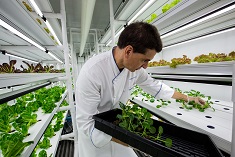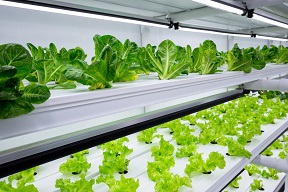 NAPLES, FLORIDA—The air outside may be a balmy 95 degrees but the temperature inside The Grow House (a.k.a. CropBox) at the Ritz-Carlton, Naples is an ideal 65 to 72 degrees—perfect for growing lettuce and other micro-greens. Since July, Executive Chef George Fistrovich has been growing the equivalent of an acre of vegetables in a repurposed shipping container that sits in the parking lot of the hotel. Measuring 40 feet by 8 feet in size, the container is equipped with everything one needs to grow crops—lights, planting racks, HVAC system, all of the necessary hydroponic components, and a system of sensors to monitor just about every environmental condition.
NAPLES, FLORIDA—The air outside may be a balmy 95 degrees but the temperature inside The Grow House (a.k.a. CropBox) at the Ritz-Carlton, Naples is an ideal 65 to 72 degrees—perfect for growing lettuce and other micro-greens. Since July, Executive Chef George Fistrovich has been growing the equivalent of an acre of vegetables in a repurposed shipping container that sits in the parking lot of the hotel. Measuring 40 feet by 8 feet in size, the container is equipped with everything one needs to grow crops—lights, planting racks, HVAC system, all of the necessary hydroponic components, and a system of sensors to monitor just about every environmental condition.
On the day Green Lodging News interviewed Fistrovich, he expected to be harvesting 1,400 heads of lettuce in the following five or six days. He and his colleagues were on their third lettuce growing cycle. “Our lettuces take 28 to 34 days to grow,” Fistrovich says. “You can watch lettuce grow overnight.” Cilantro, arugula, spinach, cabbage and other plants are also grown in the container. Cabbage takes 66 days to mature. What is grown can be enjoyed throughout the resort’s restaurants including the Italian-inspired Terrazza.
The Ritz-Carlton, Naples leases the container from Williamson Greenhouses, Clinton, N.C. Fistrovich says a colleague in Washington, D.C. told him about the CropBox and after a series of phone calls with Williamson Greenhouses the container was shipped. Everything is started from seed. Seeds are given time to germinate and then are cared for until time for harvesting. Fistrovich says he will be able to grow 365 days a year. “We use zero pesticides,” he says.
Fast Access to Fresh, Tasty Food
 The growing container complements the property’s focus on providing the freshest, tastiest food for its guests. What is grown in the container can literally go from “farm” to plate within an hour. “It is about getting the freshest product to our guests,” Fistrovich says. “It is convenient and we can grow a variety of things. It makes great sense.” Growing on-site of course eliminates the environmental and other costs associated with transporting food.
The growing container complements the property’s focus on providing the freshest, tastiest food for its guests. What is grown in the container can literally go from “farm” to plate within an hour. “It is about getting the freshest product to our guests,” Fistrovich says. “It is convenient and we can grow a variety of things. It makes great sense.” Growing on-site of course eliminates the environmental and other costs associated with transporting food.
The Grow House utilizes a 220 volt connection and currently has fluorescent lights that illuminate the interior sections of the space on 14-hour cycles. Fistrovich says a switch to UV lighting in the near future will cut lighting-related costs in half. The growing area within the container is five sections high and each section has its own growing system that uses 8 gallons of water daily. Supplies, including seeds for The Grow House, are purchased online.
Williamson Greenhouses provides Fistrovich with the ability to monitor the growing system using a smartphone. Fistrovich says he will soon have a camera in The Grow House that will allow him to monitor it using a monitor in his office.
For Fistrovich and his colleagues, farming in the container is hard work. He has had pumps break down and some flooding in the container. “I have an appreciation for what the farmer goes through,” he says. “It is not an easy life.” Regarding The Grow House style of farming, Fistrovich adds, “You have to be compassionate about it and committed to it. It takes time and the love of food. You have to study. You will have adversity.”
As a whole, however, Fistrovich says the farm in a box is his “pride and joy.”
Go to the Ritz-Carlton, Naples.
Glenn Hasek can be reached at editor@greenlodgingnews.com.







